 Weird Stuff
Weird Stuff  Weird Stuff
Weird Stuff  Health
Health Ten Confounding New Inventions from the World of Biomedicine
 Creepy
Creepy 10 Death Superstitions That Will Give You the Creeps
 Movies and TV
Movies and TV 10 Movies That Get Elite Jobs Right, According to Experts
 Weird Stuff
Weird Stuff 10 Times Real Laws Were Based on Bizarre Hypotheticals
 Animals
Animals 10 Inspiring Tales of Horses Being Human
 Mysteries
Mysteries Top 10 Haunting Facts About the Ghost Ship MV Alta
 History
History 10 Surprising Stories About the Texas Rangers
 Humans
Humans 10 Philosophers Who Were Driven Mad by Their Own Theories
 Miscellaneous
Miscellaneous 10 Video-Game-Worthy Weapons and Armors from History
 Weird Stuff
Weird Stuff 10 Warning Labels That Exist Because Someone Actually Tried It
 Health
Health Ten Confounding New Inventions from the World of Biomedicine
 Creepy
Creepy 10 Death Superstitions That Will Give You the Creeps
Who's Behind Listverse?

Jamie Frater
Head Editor
Jamie founded Listverse due to an insatiable desire to share fascinating, obscure, and bizarre facts. He has been a guest speaker on numerous national radio and television stations and is a five time published author.
More About Us Movies and TV
Movies and TV 10 Movies That Get Elite Jobs Right, According to Experts
 Weird Stuff
Weird Stuff 10 Times Real Laws Were Based on Bizarre Hypotheticals
 Animals
Animals 10 Inspiring Tales of Horses Being Human
 Mysteries
Mysteries Top 10 Haunting Facts About the Ghost Ship MV Alta
 History
History 10 Surprising Stories About the Texas Rangers
 Humans
Humans 10 Philosophers Who Were Driven Mad by Their Own Theories
 Miscellaneous
Miscellaneous 10 Video-Game-Worthy Weapons and Armors from History
10 Amazing And Little-Known Space Discoveries Of 2018
While we are about to start a new year, 2018 has been a great year for science, especially for astronomy and space engineering. Experts and scientists have made many space discoveries and advances, some of which have attracted worldwide attention.
However, many other discoveries have gone largely unnoticed by the public, although they are no less spectacular. From cryovolcanoes to extragalactic planets, we will see some of the best celestial findings and inventions that this year has left us.
10 The Largest Star Map Ever Made
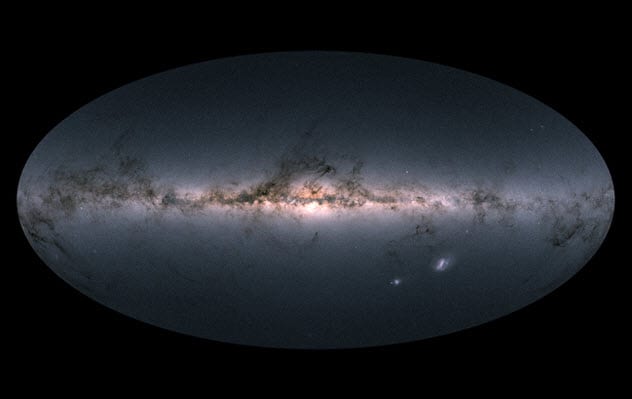
In April 2018, the European Space Agency (ESA) publicly released the largest sky map ever created to date. The map is a three-dimensional reconstruction of the sky seen from Earth, thanks to data obtained by the Gaia spacecraft.
This space probe was launched in 2013 by the same agency and is located 1.6 million kilometers (1 million mi) away from Earth. With two telescopes and a one-billion-pixel camera, Gaia’s mission is to photograph the entire sky every two months.
With the information obtained, ESA’s star map contains the brightness and position of 1.7 billion stars. This makes the map 700 million times larger than its preliminary version in 2016. At the same time, it stores data about the color and movement of 1.3 billion stars. As if that were not enough, the image shows the location of half a million other galaxies as well as 14,000 asteroids in our solar system.
This map, which will remain under construction for the next few years, is a gold mine for astronomers around the world. With such a detailed model, scientists will be able to better understand the formation and structure of our galaxy as well as find evidence of new exoplanets.[1]
9 Water Ice Found On The Moon
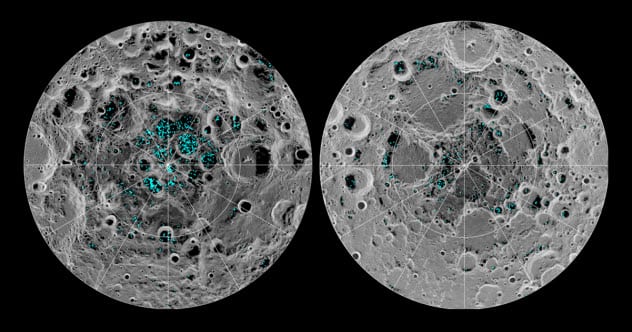
For a long time, there has been evidence pointing to the existence of ice on the Moon, but the proof has never been conclusive. There were signs of ice at the lunar south pole, for example, but these observations could be explained with phenomena other than the presence of water.
That changed on August 20 when NASA first confirmed the existence of water ice on both poles of the Moon. The definitive evidence was obtained through observations made by the Moon Mineralogy Mapper (M3), an instrument aboard an Indian spacecraft. These observations showed significant amounts of ice deposited at the bottom of several craters at the south pole. Meanwhile, the ice is more dispersed in thinner layers at the north pole.
Although the Moon’s surface reaches 100 degrees Celsius (212 °F), making the presence of liquid water impossible, the temperature in the polar craters drops to -157 degrees Celsius (-251 °F). This allows the water there to remain frozen for long periods.
This great discovery may encourage attempts to return to the Moon. Several uses for lunar water have already been planned. In some cases, it could be filtered and used for astronauts’ consumption. It could also be split into hydrogen and oxygen to provide air to humans there or for use as rocket fuel. This last option would allow the Moon to be used as a refueling stop for spaceflights to more distant places.[2]
8 We Have Learned To Remove Space Junk
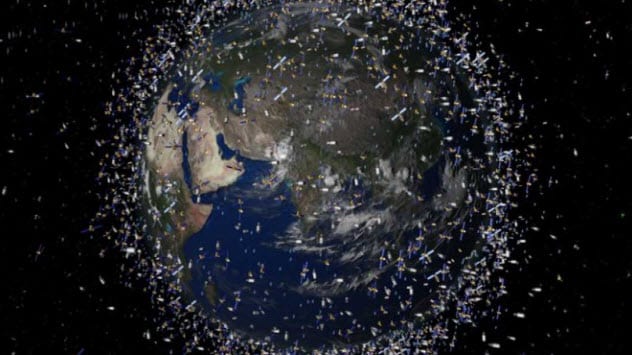
With the help of rockets, space stations, and satellites, humans have made great advances that have improved the lives of many people. But when these inventions stop working, their parts just keep floating in space as useless waste. We call this “space junk,” and there is a lot of it. Since there are millions of pieces of space debris around the Earth and a collision with these would be catastrophic, space exploration is becoming more difficult.
For that reason, scientists have struggled to find a way to eliminate space junk. This year, it seems they have found it. Researchers at the University of Surrey in England sent a satellite called RemoveDEBRIS into space.
This satellite has the mission to test four built-in technologies to try to deorbit space debris: a net, a smaller satellite, a harpoon, and a dragsail. In September, the first experiment involving the net was conducted, and the results were successful.
First, the satellite launched a piece of metal—to imitate real space junk—whose speed was around 27,359 kilometers per hour (17,000 mph). Moments later, RemoveDEBRIS also fired the net in the trajectory of the object. The cobweb-like net quickly opened and engulfed the debris without difficulty.[3]
Scientists hope that both the net and the debris will burn in the atmosphere in a couple of months. Although the novel experiment shows how promising this technology is in removing space debris, one concern is the potentially higher cost of having to clean up larger space junk.
7 Dozens Of Cryovolcanoes On Ceres
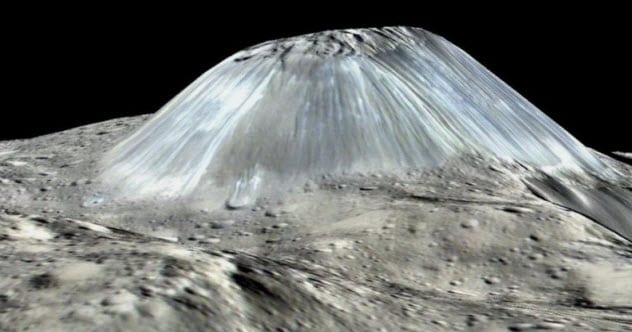
Volcanoes are not limited to being hot. We are used to seeing big mountains on Earth spitting fire and molten rock, but volcanoes on other worlds may throw exactly the opposite: ice. This type of volcano, appropriately called a cryovolcano, releases a frozen mineral substance called cryolava.
We have already shown you that Pluto has cryovolcanoes on its surface. Titan, Saturn’s moon, also has this type of volcano. But it was not until recently that we learned about the abundance of these formations in the solar system.
In 2015, the space probe Dawn began to orbit the dwarf planet Ceres in the asteroid belt while taking numerous photos of its surface. Thanks to this, scientists confirmed the discovery of a cryovolcano on the surface of Ceres in 2016. This was incredible because it was believed that the planet was geologically dead.
But that was just the beginning. In September 2018, a team of researchers published a report stating that Ceres has around 22 cryovolcanoes on its surface. Most of these volcanoes are currently inactive, although they are estimated to be less than a billion years old.
While the composition of the cryolava in Ceres remains uncertain, the cryovolcanoes in other planets expel liquid nitrogen, dust, and methane. September’s finding is extremely important because it proves that Ceres is still geologically active.
How these cryovolcanoes work exactly is a question that remains to be solved. While volcanoes on Earth act by the internal heat of the planet, Ceres does not have such energy to power its cryovolcanoes.[4]
6 The Strongest Material In The Universe
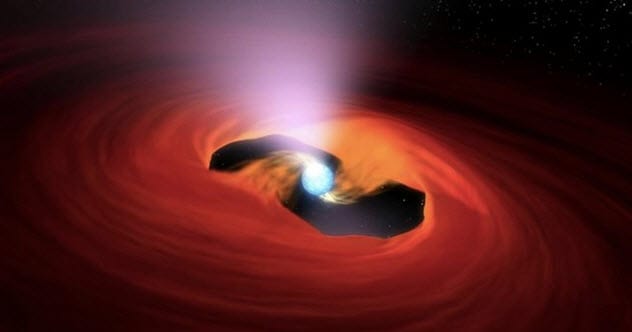
Graphene is 200 times stronger than steel. Meanwhile, a substance called carbyne is twice as strong as graphene and is considered the most resistant material on Earth. But what is the strongest material in the universe?
Well, in July 2018, scientists investigated such material inside a peculiar celestial body and carbyne pales in comparison to its hardness. At least for now, its name is “nuclear pasta.”[5]
Nuclear pasta is the substance that makes up the core of a neutron star. When a star explodes in a supernova and becomes a neutron star, its core collapses inward and stores the mass of several suns in a few kilometers in diameter. The superdense material that forms such a core takes several shapes according to its location.
Through computer simulations, scientists from several US institutions tested the strength of nuclear pasta. As the material was pushed to the limit, it was concluded that this nuclear pasta is up to 10 billion times stronger than steel. Without any other element capable of demonstrating similar properties, nuclear pasta is now the strongest material in the universe.
These results have created more questions than answers for scientists—from the necessary means to observe such material to the way in which nuclear pasta generates gravitational waves.
5 Origin Of Super-Neutrinos Discovered
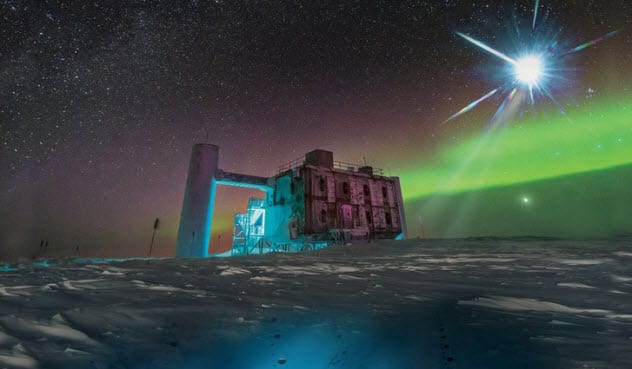
Neutrinos are subatomic particles formed in almost the entire universe through nuclear fusion processes. Due to their negligible mass and neutral charge, neutrinos can traverse almost anything without being affected at all. In fact, it is estimated that trillions of neutrinos go through a person’s body every second. Until some time ago, scientists knew that neutrinos can come from places like the Sun, supernovae, or our own atmosphere.
However, in September 2017, astronomers at an observatory called IceCube detected a high-energy neutrino that collided with the Antarctic ice. It was clear that this particle did not come from known places because it was estimated that this type of neutrino was millions of times more energetic than a normal neutrino. And if we just talked about how common the normal neutrinos are, only 10 of these new “super-neutrinos” are detected every year.
Astronomers asked to point numerous telescopes around the world to a specific portion of the sky from where they believed the super-neutrino had come. Two NASA telescopes observed that there was a blazar—a type of galaxy with a huge black hole in the center—emitting large doses of energy.[6]
In a report issued in July 2018, the researchers who made the discovery confirmed that the source of the neutrino was the blazar galaxy located four billion light-years away from Earth. This finding not only establishes the first known source of such particles but also helps scientists better understand cosmic rays, which are created along with neutrinos.
4 One Step Closer To Space Tourism
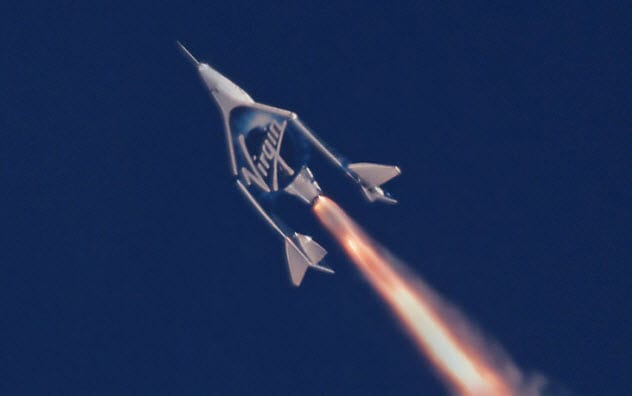
With the companies SpaceX and Blue Origin as its main competitors, Virgin Galactic was founded with the mission of making outer space accessible to tourists. However, since its creation in 2004, the private company has had many problems to overcome to reach space.
It has been about 10 years since the firm promised tourist space flights. There have been numerous delays and a fatal accident in 2014. But after all, it seems that the time has come for Virgin Galactic to finally achieve its goals.
On December 13, 2018, Virgin Galactic completed the first spaceflight of its history using its VSS Unity spaceplane. This was also the first manned spaceflight launched from American soil since the last flight of NASA’s space shuttle in 2011.
The spaceplane—an aircraft capable of going to space, returning to Earth, and landing like an airplane—was carried by another aircraft called WhiteKnightTwo to a height of 13 kilometers (8 mi). From there, the VSS Unity separated, ignited its engines, and flew to a height of 82.7 kilometers (51.4 mi) at a speed of Mach 2.9.[7]
At that point, the spacecraft exceeded the 80-kilometer (50 mi) limit that NASA considers to be the beginning of outer space. For this reason, Mark Stucky and Frederick Sturckow, the pilots of the VSS Unity, will receive their private astronaut wings next year.
However, others argue that the aircraft did not reach space by not exceeding the Karman Line at 100 kilometers (62 mi) high, which was internationally established as the edge of space. Either way, this achievement gives Virgin Galactic the confidence it needs to continue with the tests before its first commercial flights.
3 The First Planets Found In Another Galaxy
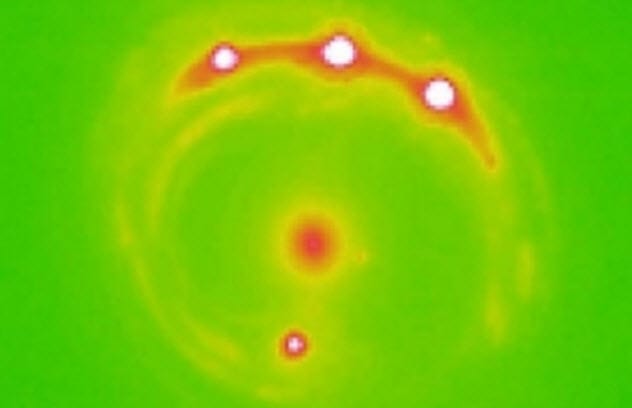
To date, we have found almost 4,000 planets outside our solar system. Even so, all these exoplanets have been located within the confines of our galaxy, the Milky Way. Until now. Early in 2018, astronomers at the University of Oklahoma detected for the first time in history a group of exoplanets in a galaxy far, far away.
To achieve this finding, scientists used a method that involves a physical phenomenon called “gravitational microlensing.” It happens that celestial bodies of large mass like black holes and galaxies have the capacity to bend light around them.
In this case, a galaxy located 3.8 billion light-years away from Earth magnified the light of four distant quasars located directly behind the structure. Thus, the “background light” of the quasars allowed astronomers to observe dark objects such as planets inside that galaxy.
The researchers were able to detect around 2,000 planets, ranging from the mass of the Moon to that of Jupiter. Until that moment, there was no real evidence of exoplanets outside our galaxy.
Researcher Eduardo Guerras said that not even the best telescope we could imagine would be able to directly see such planets. That is why the “microlensing technique” is an invaluable resource for many astronomers around the world.[8]
2 The Creation Of The Coldest Object In Space

The states of matter that people know well are solid, liquid, and gas. Some others may know the fourth state, which is plasma. But there is a fifth state in which matter can be found, and it is known as Bose-Einstein condensate (BEC).
BEC occurs when atoms are cooled to extremely low temperatures which cause them to stop moving and begin to group together as if they were a single “super atom.” This exotic state was first theoretically formulated in the early 20th century, but it was not until 1995 that scientists could artificially recreate it in a laboratory.
Due to the peculiar physical characteristics of Bose-Einstein condensate, scientists can use it to study quantum effects on a large scale. However, on Earth, the BEC must be suspended with lasers or magnets. Otherwise, the atoms disperse and change state.
But that is no longer a problem. In July 2018, scientists on the International Space Station (ISS) cooled rubidium atoms until they reached the BEC state. As gravity is negligible at that height in space, it is easier to manipulate such matter up there, even for a longer time.
To perform the experiment, NASA sent a machine called Cold Atom Lab to the ISS. This device, which is the size of a small refrigerator, can contain the Bose-Einstein condensate inside it as well as be controlled directly from Earth. It is interesting to note that this exotic matter has also become the coldest object in outer space, although not the coldest in the universe.[9]
1 A Lake Of Water On Mars
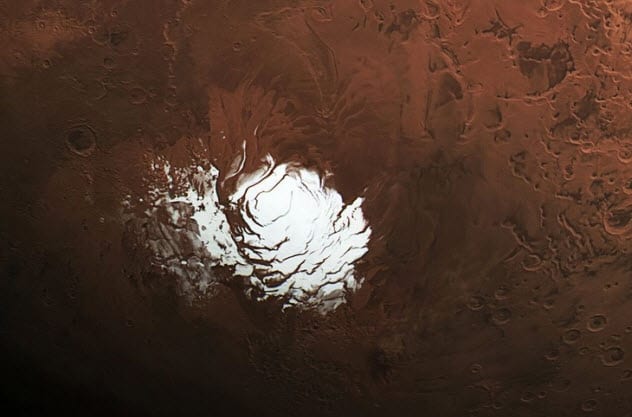
For decades, scientists have debated about the possibility of large reservoirs of water existing somewhere on Mars. Due to the extreme conditions of the Red Planet, the scientific community is focusing on searching for underground water deposits because they could be the only places capable of sustaining life on that planet.
With hostile temperatures of -62 degrees Celsius (-80 °F) on the surface of Mars, astronomers have been able to notice only some flows of super-salty water in a liquid state. Meanwhile, the rest of the water seemed to be frozen in layers of ice as in the polar ice caps.[10]
To the surprise of many, scientists from the European Space Agency (ESA) detected for the first time a large body of liquid water beneath the Martian surface in July 2018. Using a radar instrument from the Mars Express orbiter probe, the team found strong evidence of a water lake 20 kilometers (12.4 mi) long near the south pole. This lake is buried under 1.5 kilometers (0.9 mi) of ice and would be at least 1 meter (3 ft) deep.
It is still unknown why water is liquid in that reservoir, where temperatures could be as low as -68 degrees Celsius (-90 °F). But it could be a combination of the enormous pressure at that depth, underground air pockets that retain the planet’s internal heat, and large amounts of dissolved salt in the water. In any case, this finding increases the hope of scientists being able to find life on Mars.
Brian is an economy student, passionate about graphic design, and an avid enthusiast of the art of writing.
Read about more amazing space discoveries on 10 New Space Discoveries With Crazy Cosmic Consequences and 10 Recent Space Discoveries No One Can Explain.








